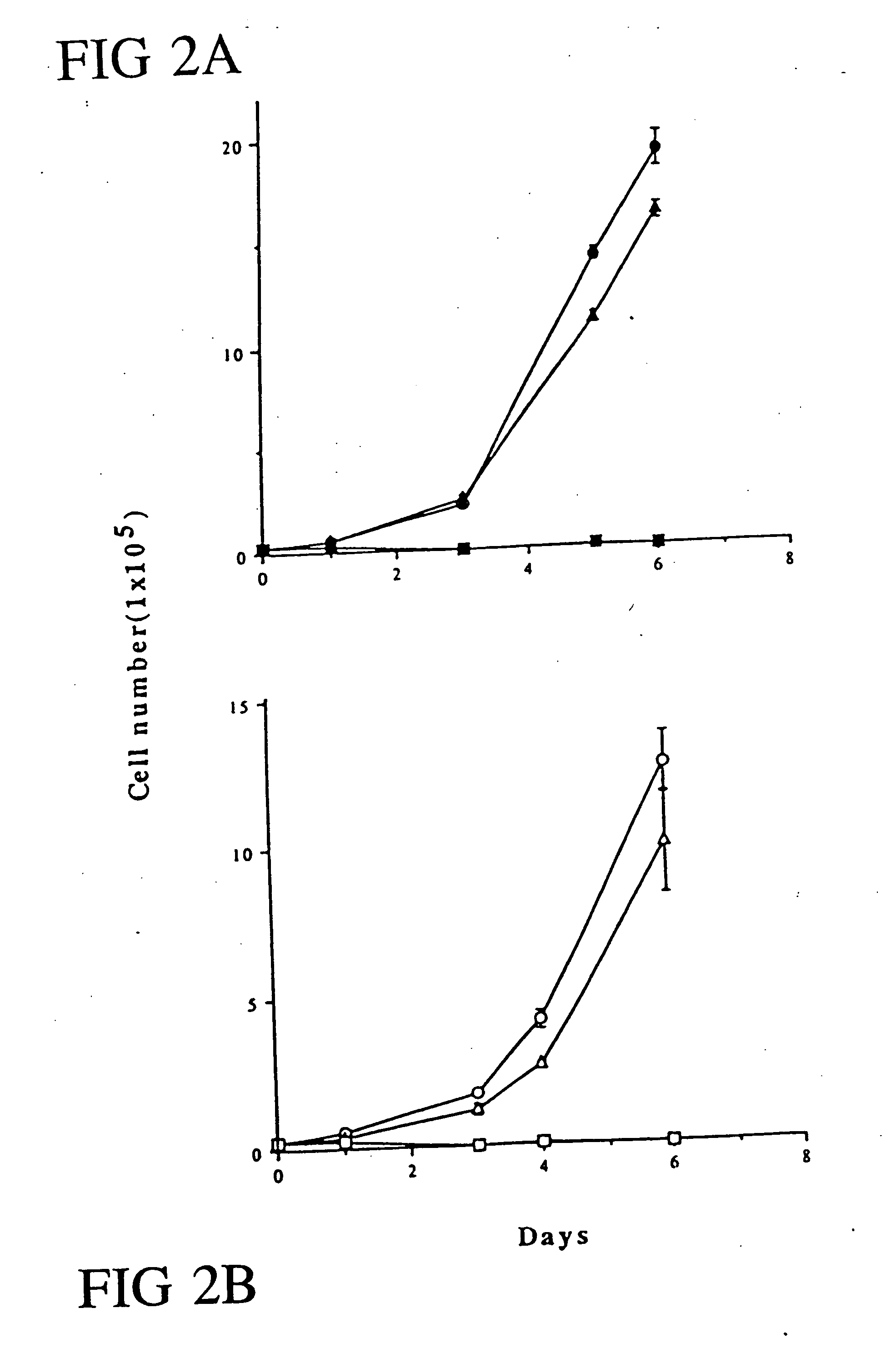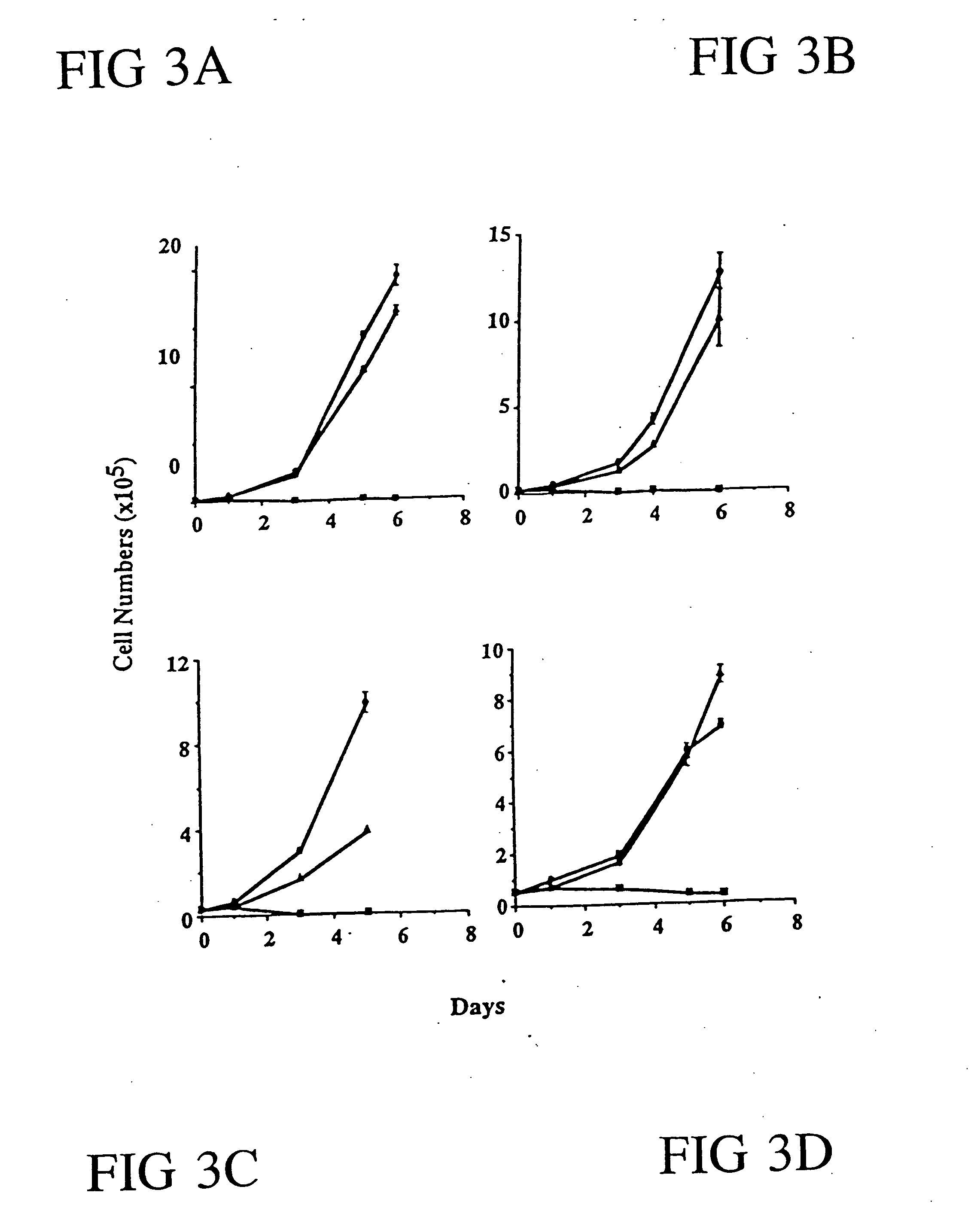Methods and compositions for the diagnosis and treatment of cancer
a technology of compositions and cancer, applied in the field of cancer biology, can solve the problems of half a million deaths annually
- Summary
- Abstract
- Description
- Claims
- Application Information
AI Technical Summary
Benefits of technology
Problems solved by technology
Method used
Image
Examples
example 1
Growth Suppression of Human Head and Neck Cancer Cells by the Introduction of a Wild-Type p53 Gene Via a Recombinant Adenovirus
[0154] Materials and Methods
[0155] Cell Lines and Culture Conditions. Human SCCHN cell lines Tu-138 and Tu-177 were both established at the Department of Head and Neck Surgery, M.D. Anderson Cancer Center. Tu-138 and Tu-177 were established from a gingivo-labial moderately differentiated squamous carcinoma and a poorly differentiated squamous carcinoma of the larynx, respectively. Both cell lines were developed via primary explant technique and are cytokeratin positive and tumorigenic in athymic nude and SCID mice. These cells were grown in DMEM / F12 medium supplemented with 10% heat-inactivated fetal bovine serum (FBS) with penicillin / streptomycin.
[0156] Recombinant Adenovirus Preparation and Infection. The recombinant p53 adenovirus (Ad5CMV-p53) (Zhang et al., 1994) contains the cytomegalovirus (CMV) promoter, wild-type p53 cDNA, and SV40 polyadenylation...
example 2
In Vivo Molecular Therapy with p53 Adenovirus for Microscopic Residual Head and Neck Squamous Carcinoma
[0168] Materials and Methods
[0169] Cell Lines and Culture Conditions. Human SCCHN cell lines Tu-138, Tu-177, MDA 686-LN, and MDA 886 were all established have been previously characterized (Clayman et al., 1993; Sacks et al., 1988). These cells were grown in Dulbecco's modified Eagle's medium (DMEM / F12) supplemented with 10% heat-inactivated fetal bovine serum (FBS) and penicillin / streptomycin.
[0170] Recombinant Adenovirus Preparation and Infection; Cell Growth Assay; Western Blot Analysis. All the procedures have been previously described in Example 1. Cell growth assays were all performed in triplicate.
[0171] In Vivo Transduction with β-Galactosidase Adenovirus. X-gal staining of tissue specimens were performed on O.C.T. frozen tissue sections to determine transduction efficiency. Eight-micrometer thick specimens were washed in cold PBS and fixed in 0.5% glutaraldehyde at roo...
example 3
Apoptosis Induction Mediated by Wild-Type p53 Adenovirus Gene Transfer in Squamous Cell Carcinoma of Head and Neck
[0182] Materials and Methods
[0183] Cell Lines and Culture Conditions; Recombinant Adenovirus Preparation and Infection. All procedures were performed and cell lines maintained as previously described in Examples 1 and 2.
[0184] DNA Fragmentation Analysis. Following incubation with wild-type p53 adenovirus as well as replication defective adenovirus controls at various time intervals, cells were harvested, resuspended in 300 μl of PBS with the addition of 3 ml of extraction buffer (10 mM Tris, pH 8.0, 0.1M EDTA, 20 μg / ml RNAse, 0.5% SDS) and incubated at 37° C. for 1-2 h. At the end of incubation, proteinase K was added to a final concentration of 100 μg / ml and the solution placed in a 50° C. water bath for at least 3 h. DNA was extracted once with equal volume of 0.5 M Tris (pH 8.0) saturated phenol then the extraction repeated with phenol / chloroform. Precipitated DNA ...
PUM
 Login to View More
Login to View More Abstract
Description
Claims
Application Information
 Login to View More
Login to View More - R&D
- Intellectual Property
- Life Sciences
- Materials
- Tech Scout
- Unparalleled Data Quality
- Higher Quality Content
- 60% Fewer Hallucinations
Browse by: Latest US Patents, China's latest patents, Technical Efficacy Thesaurus, Application Domain, Technology Topic, Popular Technical Reports.
© 2025 PatSnap. All rights reserved.Legal|Privacy policy|Modern Slavery Act Transparency Statement|Sitemap|About US| Contact US: help@patsnap.com



